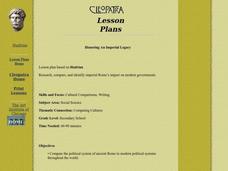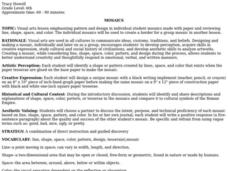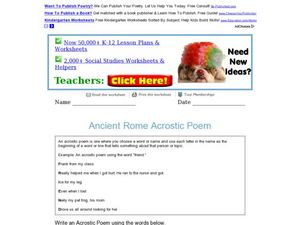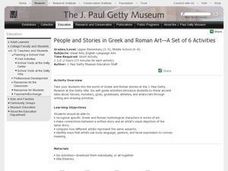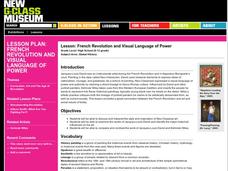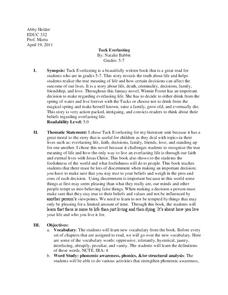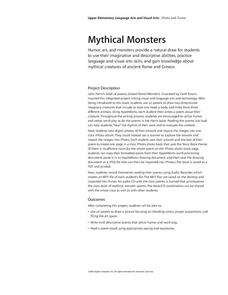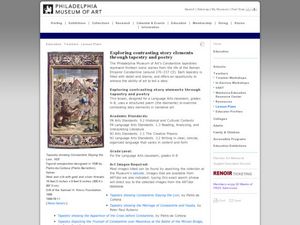Curated OER
A Day In The Life
Students create an online newspaper documenting the politics and culture of ancient Rome. Using online tools and websites, they conduct research on ancient Roman politics and everyday culture. The informaiton gathered is used to create a...
Curated OER
Honoring An Imperial Legacy
Students research, compare, and identify imperial Rome's impact on modern governments. They compare the political system of ancient Rome to modern political systems throughout the world.
Curated OER
Mosaics
Sixth graders discuss and identify shapes, spaces, colors, patterns, or tesserae in mosaics and compare them to cultural symbols of the Roman Empire. They design and create mosaics using paper.
Curated OER
Religion: Great Schism Debate
Learners examine the Great Schism in the Roman Catholic Church and research the positions of the three popes. The three groups research their popes' positions and then hold a debate. Students write position papers about the Great Schism.
Curated OER
The Art of Imitation: Writing an Aristotelian Tragedy
Learners, after exploring the history of tragedies and analyzing Aristotelian elements in Greek/Roman tragedies, create their own tragedy set in modern context. They formulate their creations from an Aristotle platform. In addition, they...
Curated OER
Ancient Rome Acrostic Poem
For this acrostic worksheet, students read about creating an acrostic poem, then write one using "Ancient Rome." Worksheet contains links to additional activities.
Curated OER
Magazine Mosaics
Almost every teacher has a stack of old magazines lying around. Get creative and turn them into mosaics! That's right, this resource explains how kids draw, design, cut, and paste to create mosaic art from recycled magazines. Connect...
Curated OER
Relief Sculpture in Two Parts
Learners discuss relief sculptures and examine many examples of Roman urns with relief sculptures. They consider the information these urns give us about Roman culture and then use drywall to design and create their own relief sculpture...
Curated OER
An Ancient Greek and Roman Festival
Third graders label a map of ancient Greek and Roman civilizations and do a written report on one element of these two cultures. They participate in discussions of food, farming, daily life and government (among others). Students use the...
Curated OER
J. Paul Getty Museum
Students read mythological Greek and Roman stories. In this mythological lesson plan students read mythological stories about Greek and Roman times. As they read, they compare the written story to the visual art of the story.
Curated OER
Romanticism: A Movement Across the Arts
Characterized by the five I's (imagination, intuition, idealism, inspiration, and individuality), the Romantic period saw quite a shift in the music and art production at its time. Review this PowerPoint with your class to discuss some...
Curated OER
Create a Travel Brochure
Students demonstrate an understanding of the contributions of the Ancient Roman civilization. They identify, study, and provide evidence for the significance of Roman citizenship and the spread of Christianity. Students then demonstrate...
Curated OER
Telling the Times
In this Roman times instructional activity, students view and interpret a drawing that shows a street from Roman times with soldiers and buildings. Students state what this drawing tells them about Roman soldiers and buildings.
New Class Museum
Lesson: French Revolution and Visual Language of Power
Take a look at the French Revolution and neo-classic art, then compare it to current social issues and contemporary art. Kids analyze several pieces painted by Jacques-Louis David in regard to style and subject then compare them to...
Tech Know Teaching
6th Grade Constructed Response Question
Graphs, charts, maps, diagrams. Reading and comprehending informational text is far more than just decoding the words on a page. Here's a packet that provides young readers with practice answering constructed response questions using...
Curated OER
Tuck Everlasting
Clearly written as an assignment for a higher-level education class, this formal lesson plan contains some fun and well-researched strategies for teaching the novel Tuck Everlasting by Natalie Babbitt. Among the best ideas...
Trinity University
Julius Caesar: The Power of Persuasion
"Friend, Romans, countrymen, lend me your ears..." Those words begin one of the most persuasive speeches in literature. Explore the elements of persuasion in a series of lessons related to William Shakespeare's Julius...
Curated OER
Mythical Monsters
Students design mythical creatures and write poems about them. They take digital pictures of their artwork and create a digital picture book. They record their readings of the poetry to be added a class recording.
Curated OER
DRYWALL CARVING
Students study relief sculpture and architectural elements, discuss Egyptian hieroglyphics and relief sculptures that can be seen on Roman and Greek structures, and create a relief sculpture using drywall.
Curated OER
Egg-citing Easter Art Activities
Easter art projects can be used to teach students about a variety of cultural art forms.
Curated OER
All Things Brought to Rome
In this anagrams worksheet, students study, analyze and unscramble 8 words or phrases of essential items that were brought into Rome.
Curated OER
Research Skills: Evaluating Information and Sources
While this focuses on Ancient Rome, the objectives are improved research and information evaluation skills. In one class period, class members narrow their topic, research it, select the best information, log useful sources, and discuss...
Curated OER
Exploring Contrasting Story Elements Through Tapestry and Poetry
Young thinkers view two narrative art tapestries and study the images included that tell a story about the Roman Emperor Constantine. As they examine the details of the tapestries, pupils use a Venn Diagram to record the similarities and...
Curated OER
Mythological Goddesses: Worldwide
From Celtic, Egyptian, and Roman myths, the goddesses of various world myths are the focus of this quiz. Basic identification of these characters compose the ten questions. Check your readers' understanding after studying world myths and...

